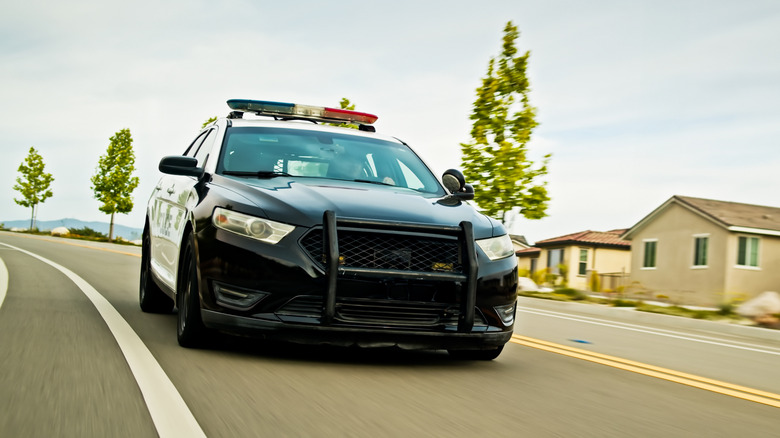Do The Back Of Police Cars Have Seat Belts?
No one ever wants to be in the back of a cop car, but you may still wonder what it's like there. You may already know about the equipment console, plate number-running computers, protective plexiglass, or even the interior nighttime red lights, but the seats and their seat belts are a lesser-known yet important detail of modern law enforcement vehicles. Of course, with the exception of one state that doesn't legally require them, seat belts are mandatory nationwide, so it's unlikely police officers would be transporting detainees without a safety restraint.
The seats themselves are usually made from molded plastic or tough vinyl instead of the soft cloth or leather you'd find in a civilian car. It may be uncomfortable, but it makes cleaning messes like blood or vomit easier. And yes, there are seat belts back there, though they're not quite like the ones you buckle up with in your own car. Many police departments use specially mounted belts that let the officer fasten in a passenger from the outside, keeping control out of the detainee's hands and preventing the belt from being used as a weapon. While some may know these as "outbound" seat belts, the correct terminology is "outboard" seat belts and they come in a few variations.
What are the different designs of police car seat belts?
One of the most common police car seat belt designs is the center-pull system. In this setup, the belt originates from the center of the rear seat and can be pulled across the detainee from the doorway. According to police vehicle upfitter Setina, the key benefit is that it eliminates the need for officers to reach across the passenger when securing them. This helps reduce the risk of close contact and improves safety as a result.
Another approach is the retractable outboard seat belt system, provided by companies such as Pro-Gard. This design sees the buckle stalk mounted closer to the outer door edge of the rear compartment. This allows the officer to secure the detainee from outside the vehicle, once again minimizing physical interaction while keeping the process well-controlled.
More advanced systems even have smart features such as Setina's SmartBelt – which is distinctly different from a regular seat belt. It integrates an automatic locking mechanism and even provides an alert if the belt is unbuckled during transport. This smart seat belt still functions in the event of a power loss, helping police officers make sure that detainees remain restrained throughout the ride.

